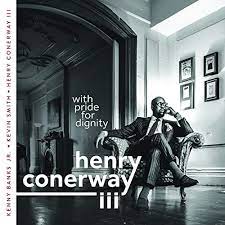
Review: Henry Conerway III | With Pride For Dignity
Smile is what you do when hearing a compelling sound. That is exactly what I did when the first notes of the opening track filled the room. It takes a bassist to arrange a bassist’s composition and make it fresh.
Hailing from the Motor City, Henry Conerway honed his skills in the hallowed halls and practice rooms of Morehouse College as well as the stages of Atlanta clubs. This adroit but ever humble practitioner enlists two of the city’s finest jazz purveyors to accompany him on this sojourn through time – pianist Kenny Banks Jr. and bassist Kevin Smith. His musical acumen is steeped in the history and tradition of jazz, making his choice of compositions from the pantheon not so startling as he ventures through three generations of jazz masters and contemporaries – Ray Brown, Phineas Newborn, Duke Ellington, Jimmy Heath, Marcus Printup and Kenny Banks, Jr..
It is a well known fact that one should not take on a classic if one can bring nothing new to the canon and Ray Brown’s Slippery is one such composition. Conjuring up a myriad of thoughts as to what he may have been thinking when he composed this song, the trio puts its own spin while taking each listener on a personal sojourn with a new arrangement by Smith, raising the tempo ever so slightly to give it a fresh sound. The title track, With Pride For Dignity, composed by Banks begins quietly with a piano solo, that immediately put me in the revered mood of Danny Boy then quickly sent me to the equally reverent first line of New Orleans before stealthily moves through a series of jazz periods, giving one a sense of the pride and dignity of this recording session. Newborn’s composition Sugar Ray elicits thoughts of the great pugilist named Robinson, illustrating the grace and style with which he fought. Of course, with later generation the song could have meaning for Leonard or even Richard Pryor’s role in Harlem NIghts depending on perspective. His choice of the 1940 Ellington composition Cottontail, written for orchestra, deftly translates the emotion into a trio setting with all the tempo and panache a big band would express. Smith quickly walks the bass as he paces the music leading into the brush work of Conerway. I could have been in the Savoy Ballroom testifying to this performance as Jitterbuggers or Lindyhoppers paraded the floor.
Hopscotch by composer and irrepressible trumpeter Printup is not the stuff of school girls tossing stones and jumping in chalk-lined squares but exhibits a similar humor of adults reminiscing those sidewalks as the trio swings this one. Heath’s Gingerbread Boy proves that jazz is never easy and placing it among such revered company is the epitome of this talented threesome true to their character. Banks follows this with another of his compositions The Feel Goods with a short overture that leads into a hip swing that best exemplifies the best times of our lives. Conerway closes with Carvin’s Agreement, an original composition he penned to pay tribute to one of his teachers, Michael Carvin, showing us just what drums can do.
Conerway’s svelte delivery as a leader keeps him in stride with his compatriots who swing equally gentle or sassy when called upon. An inventive drummer, he carries each song with equal parts to his companions, never overshadowing the others. Having witnessed the growth of these young men over the years, they were satisfied on many an occasion to sit unnoticed in the audience while gleaning pointers from the masters, a practice few young musicians find a need to do in this day and age. Like all great musicians they also realize there is still much to learn, more growth to take place. So it is no surprise their evolution into this cohesive unit affords them the facility to ply their trade as well as they do. They are more than musicians, they are friends who can start, carry and finish each other’s musical conversation when required. However, I beseech you to not overlook the liner notes so eloquently written by esteemed saxophonist and professor Dwight Andrews. Also do not dismiss the cover photography of any album because there is always a story, one deeper that you may surmise. This photograph was decidedly taken upon Henry’s request during a visit to the home of Langston Hughes. Historic on many levels.
Much more cannot be said of this album other than this is not a quick listen to see if you like it. You will. So take note music directors and programmers, it is radio friendly. You don’t need to skip tracks without listening to each one fully. If you must skip tracks it is my hope that you have a favorite song on this project and anticipation of getting to it is unbearable to see the trio’s approach. Whatever you do, this album speaks for itself and is a testament to the volumes of knowledge these industry-respected practitioners have about the music they have given their lives to enjoy performing. This is with pride for dignity and well worth the nod from their peers and a well-deserved Grammy nomination from the Recording Academy. Listen. You will be pleased.
carl anthony | notorious jazz | november 17, 2018
Give A Gift Of Jazz ~ Share ![]()
#preserving genius
More Posts: bandleader,drums,history,instrumental,jazz,music,review
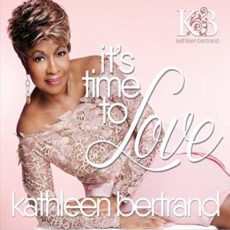
Review: Kathleen Bertrand | It’s Time To Love
It’s Time To Love is a statement of purpose that is anything but simple. Knowing Kathleen as I do there is more than one layer to everything she does. I found this not only to be a personal message but a global appeal. On this project she pulls from several different sources and vantage points, distinguished by the cadre of the elite hometown musicians she has invited to have fun with her.
Her approach is unmistakable – pure and filled with joy. There is a clarity in her voice that is immediately recognizable from the first note you hear. Toss into the mix some very creative arrangements and you understand why Ms. Bertrand wholeheartedly believes it is time to love.
Bringing an impressive compilation of nine standards, originals, classic soul and gospel, she kicks off this offering with the title track that she composed with her musical director Phil Davis. Maintaining the groove she seamlessly moves into Diamonds, written for Rihanna’s 8th album, proving that no song is far from jazz with the proper arrangement. Reaching back to the 1946 musical St. Louis Woman she brings into the new millennium the classic Arlen/Mercer tune Come Rain Or Come Shine in an easy rendition that expresses yesterday’s view of today’s ride or die.
Always one to illuminate the talents of young writers she augments Tony Hightower’s Baby I’m Yours with additional lyrics, giving a lyrical homage to that very special person. Heading back to Broadway she juxtaposes the question of love with a 1947 Lerner and Loewe composition Almost Like Being In Love from Brigadoon, that has one understanding the feeling of being alive. Teaming up once again with Davis, their reputation as composers and arrangers firmly established, they pen and deliver another original Walking Through The Door, be it expectation or surprise, the need is the same. Walking us back in time to the Sixties and the music of another renowned team of Bacharach/David with Anyone Who Had A Heart.
Never far from the church, Kathleen chooses to rearrange with the assistance of Tyrone Jackson, the traditional It’s Me (Standing In The Need Of Prayer). As I listen to her rendering me back to my childhood, I am hearing so much of Mahalia Jackson in this passionate acknowledgement to the higher power. Closing out this recording she moves the message back to the joy of love with the Richard Clay, Carl Clay and Wayne Garfield composition Love From The Sun, made famous by Norman Connors. However, she turns once again to emerging artists, The Dangerfield Newbies, to arrange and produce this classic tune, clearly making this her own, as she inimitably does with every song she touches.
Earlier in this review I mentioned the elite cadre of Atlanta musicians and I would be remiss not to list them and allow you the opportunity to catch them in live performance when their names come across your radar. Order of appearance of the recording: Phil Davis, Rod Harris, Jr., Melvin Jones, Mike Burton, Katy Miner, Tyrone Allen, George Caldwell, Sean Jefferson, RiShon Odel, Russell Gunn, Robert Boone, Frankie Quinones, Joel Powell, Tyrone Jackson, Mace Hibbard, Sam Skelton, Kevin Smith, Chris Burroughs, Nelson Render and Marvin Pryor.
To say Kathleen Bertrand is an original does her a disservice for we are all one of a kind. What sets her apart is her innate ability to select and align songs in a manner that makes you anticipate hearing what comes next and a little saddened when the last song plays out. This album celebrates and laments the many facets of love. It is an enjoyable escape and journey through one’s heart, as we have all been where each songs takes us, that is, at one time or another. The one thing I know to be true, with Kathleen Bertrand, there will always be more and the best is yet to come.
carl anthony | notorious jazz | september 23, 2018
Give A Gift Of Jazz ~ Share ![]()
#preserving genius
More Posts: bandleader,history,instrumental,jazz,music,review,vocal
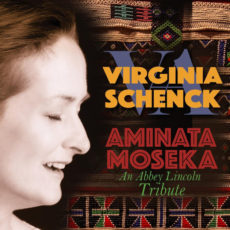
Review: Virginia Schenck | Aminata Moseka
Whenever I hear the word ambitious used by critics, I take pause, because it rings of a generosity that references an artist who has made a conscious decision to cover the music of an icon. The artist is often convinced that they have the chops to give a new life to the music; however, they are often the singers who release the adequate. And then there are those vocalists who are the light at the end of the tunnel and successfully walk into posterity. This offering by Virginia Schenck, however, happens to be a case of the latter and this is her moment.
The last time I saw this talented interpreter of lyrics I was amongst a gathering of jazz enthusiast under a beautiful Atlanta evening sky. During her set while singing Caged Bird, providence stepped forward and a small flock of birds answered her call with an appropriate and timely response. I knew a higher power was at work and everyone felt the energy pass throughout the audience. There are very few occasions when I experience a connection with nature in an urban setting as I did that night.
So to choose to pay homage to a poet of Abbey Lincoln stature was not only adventurous but exhibited a resolve that resulted in a highly rewarding experience. As I sat listening to Virginia’s delivery, with each composition hope blossomed again and again into a blissful reality. This was no mere one or two listens to this compendium of songs, but a dozen or more at different times in light and darkness, at different levels of volume and not all songs at the same time. I became engrossed in the conversation between musicians and heard the joy and pain, the laughter and sadness, the troubles and the victories as each song unfolds and began feeling the spirit of Abbey in every word from this messenger.
Though the subtitle states this recording is a tribute, this is so much more. It is a conversation between Abbey and Virginia. If you are familiar with Ms. Lincoln, then you know each vocalist is holding her own tempo and pacing within the understanding of the lyrics. Ms. Schenck’s choice of compositions were well thought out, with a precision that compliments her voice and clearly represents thirteen of Abbey’s best. To be true to the emotion and exhibit every side of the composer, these musicians invite you to be privy to the conversation between poet and vocalist.
Virginia hangs with a few of Atlanta’s best in the recording studio for a session that may appear perfunctory, however, it is the banked talent that makes it look and sound effortless in their execution that allows one to hear the voice until it’s time for the musicians to shine. With Kevin Bales tickling the 88, Rodney Jordan walking the bass, Marlon Patton keeping time on the drums and their special guest on alto saxophone Kebbi Williams, they bring a fresh breath of interpretation to these 13 songs. It is here that we hear the musical dialogue between the rhythm section and Virginia as they playfully emote their understandings. Kebbi’s frenetic improvisation keeps pace, adding complementary emphasis to Schenck’s spoken word of The River.
The arrangements. Listen but listen most carefully and you will hear the subtleties in the playing of piano, bass and drum that will entice you to desire more. This project goes beyond the borders of convention as collectively and individually each musician contributes their thoughts to each song that will touch, move and inspire each listener differently.
So, suffice it to say, Ms. Schenck has made a joyful noise in honoring one of America’s preeminent lyricists by crossing the borders of time, race and emotion with Aminata Moseka. She has raised the bar a few feet and what she leaves behind is an indelible audible mark on the industry that she loves. I would be remiss if I didn’t compel you to sit and listen, then read the liner notes for context, then listen again to truly hear the magic of Virginia and company talking to the sun.
carl anthony | notorious jazz | august 28, 2017
Give A Gift Of Jazz ~ Share ![]()
#preserving genius
More Posts: bandleader,history,instrumental,jazz,music,review
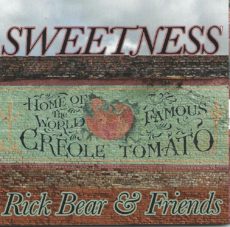
Review: Rick Bear & Friends | Sweetness
If you’ve ever been to the Crescent City, then you are well aware of the charms that seduce its visitors, as its residents are already under the city’s spell. Within its confines and in neighboring jurisdictions belies a cornucopia of delights in the aromas of varied cuisines, ample drinks and lots of music. It is, however, the latter that embraces and stimulates the enthusiast and aficionado to move to the myriad of rhythms.
So don’t allow the cover art to tempt you to pigeonhole this group of world class musicians in some staid understanding of what NOLA offers, for you just may miss their stellar performances. And for you initiates who have yet to sample the delights there is no better place to begin your journey than with a tasting of Sweetness. This is a recording representative of the talent that continues to spring forth from the city that has heralded the title of the birthplace of jazz.
Sweetness not only lends itself to the cuisine of the Crescent City but also invokes the very nature of the musicianship that is its tapestry. Herein lies the beauty of the compositions performed by drummer Rick Bear, guitarist John Fohl, bassist Jason Stewart and trumpeter/trombonist Ken Gregory. Stir in the piano and organ of Herb Avery and the vocals of Hampton B. Cole and you understand why jazz remains such an integral component to the gumbo that is New Orleans.
The base ingredients of this gumbo of compositions are Bechet, Waller, Rodgers & Hart, Henderson, Monk, Mitchell, Hines, Hancock, Ronell, Patton and Bernie who set the stage for this compendium of jazz standards. There is nothing subtle about their choices as they pay homage to the jazz canon and the Great American Songbook. So put aside any and all biases as to what may be and enjoy listening to these arrangements.
The set opens with the Sidney Bechet classic Petite Fleur where Spanish trumpet and French guitar influences conjoin in a flourish of style. The rest of the album follows with jazz standards – Willow Weep For Me, Rosetta, My Funny Valentine, Honeysuckle Rose, Bye Bye Blackbird, ‘Round Midnight, Hard Times, Jitterbug Waltz, Cantaloupe Island, Funky Mama and Sweet Georgia Brown.
Gregory takes the lead on most songs and his interpretations of My Funny Valentine and Round Midnight, the two ballads presented here, mournfully take you into a place of melancholy. The trumpet and trombone spell out his attributes, begging Valentine not to leave. On the latter, Fahl’s guitar quietly releases the anguish of a soul as it spells out its woes.
Hard Times is juxtaposed against its name with a rhythm that is anything less than enjoyable. Composed by Paul Mitchell during the turbulent Sixties, Americans on both sides of the struggle found lighter moments. Just the same way society did in finding its fun during the war years in the Jitterbug Waltz of Fats Waller.
Fohl opens up Cantaloupe Island with an easy strum and accompanies Gregory through what puts me in the mood for a hammock, warm breezes, sand and a cooler as the Hammond B3, guitar and the trombone swing you into a toe-tapping, finger snapping mode on Funky Mama. The closing tune on the album, Sweet Georgia Brown, opens with a rim shot staccato and ends the set on a fun note, a fitting tribute to the vocals of their recently departed friend, Colonel Bruce Hampton (Hampton B. Cole), making this final studio recording and an apt farewell.
Throughout the project, Rick Bear leads his compatriots and keeps time, allowing each musician to bring his sensibility to the signature sound that emanates from this city. Subtle though it may be, this session extolls a synchronicity in the songs that tell stories that are American made, as are the players whose star-power has not diminished.
To return to an earlier statement, allow me to clear up any misconception it was not my intent to disregard the thought behind the cover. I merely mentioned not to be distracted or form an opinion of what lay behind because there is a sellable story in the art. The missing part of the sign painted on the side of the building is A. J. ‘S Produce Co. Inc, 3162 Chartres. Angelo Benandi, the son who broke away from the family produce business at the French Market, established it in 1983. The Creole Tomato is grown in Louisiana soil in the river parishes along the Mississippi where the soil is richer. They are large, meatier, heat resistant, stay on the vine longer and hit the table so much sweeter. So when you’re down in New Orleans feel the pulse of the city, have a robust taste of homegrown and you’ll begin to understand the flavor that is The Big Easy.
carl anthony | notorious jazz / august 3, 2017
Give A Gift Of Jazz ~ Share ![]()
#preserving genius
More Posts: bandleader,drums,history,instrumental,jazz,music,review
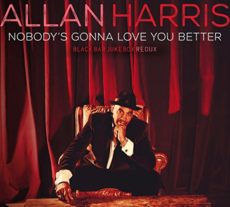
Review: Allan Harris | Nobody’s Gonna Love You Better
Choice, style and interpretation are the cornerstones of this vocalist who has an innate ability to proffer songs that allow him to eloquently emote. Having followed his career over the years there has been little he has been unable to do. Bringing four songs to the session that he penned, Allan deftly selected seven additional tunes composed by music’s elite that crosses all genres. Coupled with this, is his choice of musicians who pull off this roundhouse of songs that will definitely knock your socks off, if not off your feet. After numerous listening sessions and dancing around myself, I warn you now and it is my suggestion that you prepare to move about unabashedly through a variety of tempos. What is truly amazing is that Harris pulls this off without the use of any brass or wind instruments, producing not the sound but the feel of a Sixties rock and roll rhythm section.
This latest offering, Nobody’s Gonna Love You Better is evidence of that fact. An accomplished composer and lyricist, Allan kicks off this compendium of music with the uptempo wisdom of Mother’s Love, the formal name of the title track. Ever the griot, Harris plants thoughts worthy of rumination without being preachy but more of a gentle reminder for every son. He returns with Steely Dan’s brotherly advice by telling us Any Major Dude Will Tell You, giving the listener another lesson in keeping it real.
Covering a hit song is always a tribute to the original artist and requires it be performed just as well if not better. If you were around in 1969 then you remember a quintet called the Spiral Staircase who made More Today Than Yesterday popular for a couple of generations coming of age. Putting the right amount of swing in the mix he stays in the pocket with a big scoop of organ that will have you patting you foot and snapping your fingers, if not dancing around the house.
Giving us the opportunity to breathe a little lighter he drops down to ballad tempo to deliver a heartfelt rendition of the Johnny Mercer/Victor Schertzinger tune I Remember You. Love lost is not love forgotten and Mercer penned this song to Judy Garland, reminiscing over their short-lived romance when she was just 19. For those who may ask has Harris gone through this heartache himself given his superb delivery or like the bass keeping the heartbeat alive, does he just understand the emotional distress in the words, as does pianist Pascal Le Boeuf, who mirrors the sentiment throughout. Be comforted that he is just that good.
Rising up from the samba of Bahia, the bossa nova craze of Rio took the world by storm when the movie Orfeu Negro (Black Orpheus) hit the silver screen. Out of that explosion was birthed a host of composers, musicians and singers that included Dorival Caymmi and Antonio de Almeida who wrote Doralice. Fluently beautiful in the Portuguese language, Allan transports easily us to the side of her lover who is in strife because he loves her so but wants no wife, so he asks her what are they to do. For Brazil and bossa nova, it is nearly always about love. The rhythm is deceptive in its lightness for these star-crossed lovers.
Time has no meaning when one searches for the right song to add to their playlist and the Fields/McHugh tune I’m In The Mood For Love fit the bill perfectly. It was, however, refreshed with an improvised solo on the 1935 melody by James Moody and the lyrics by Eddie Jefferson, we add to the Great American Songbook the tune Moody’s Mood For Love. Harris stays away from the original rendition of performing the woman’s response in a high voice, delivering his version in ballad and taking the woman’s response to a mid-tempo beat and finishing his final words with brashness befitting someone who is smitten and confident and laying his emotions on the table.
Swing says it all in the title and having penned this one himself, Allan celebrate the big band era when teenagers and young adults all over America filled ballrooms like the Savoy, Palomar and Trianon and danced to jazz by Ellington, Goodman and Basie. A fitting tribute to the country’s most popular music between the Depression and a World War.
Hollywood is not off limits for this purveyor of song as he takes the theme song composed by Heinz Roemheld for the film Ruby Gentry. The lyrics by Mitchell Parish were added long after the tune had received wide acclaim. With a tempo suitable for dancing cheek to cheek, Harris speaks to the heart of the Ruby lyric and exposes the anguish, love and futility for this beauty that only the unloved would know. One will notice the bass line quietly captures the mood, with guitars in tow.
Your toes will tap once more as you are introduced to a swinging version of Jimi Hendrix’s Up From The Skies. This exemplifies Harris’ true talent in taking a rock song and giving it new life in jazz. The arrangement features the Hammond B3 gives it the punch need to get you on the floor or at the very least bopping in your seats and leaving you exhausted.
Blue Was Angry comes from the musical Cross That River that he wrote about the Black contributions, trials and accomplishments in the expansion of the West. Closing out this concert with a final ballad that he penned Secret Moments, he leaves us with a bit more wisdom about love and life.
I would be remiss if I didn’t pay my respects to the band that put in the hours to make this a winning project. Joining Allan Harris on Vocals, Acoustic Guitar, Resonator Guitar, D’Angelico Electric Guitar are Russell Hall – Acoustic Bass, Electric Bass; Pascal Le Boeuf – Piano, Fender Rhodes, Hammond B3; Shirazette Tinnin – Drums, Cajon; and Freddie Bryant playing Electric Guitar and Classical Guitar. Listening to them perform I can only surmise they truly had fun putting this one in the can and look forward to hearing them live. You chose well Mr. Harris.
What caught my eye at first glance were the classic songs that were chosen and the order in which they were placed. Introducing new songs, especially those you pen yourself, can often be a difficult task, but he does it well mixing them into the lineup. Next my ear was put to task to stay with a song to see developmental possibilities. As a deejay, I look for order and I will give any artist one opportunity to delight me. The song order in which Harris chose to present was pleasantly received having no inclination to skip a song or change the order. I was taken through all the emotions these composers and lyricists put into their compositions and felt buoyant and fully entertained. I heard versions of classics that were unexpected but fresh in their arrangements. If this is his brand, and I believe it is, he is not to be typecasted but embraced for the pioneering spirit that pushes his envelope to include all genres in this tapestry we call jazz.
For in this disposable world of short attention spans, where music is in your pocket, sold by the track, a click away from changing a song and one cannot listen longer than thirty seconds, there is no more getting up or walking across the room to the turntable, lifting the needle, moving to the next song or having to flip to the B side. I recognize the amount of thought that went into the order of his lineup and hopefully you will also. It may be a rollercoaster ride of emotions that begins on the downhill side of the first climb, winds around all the emotional twists and turns the music offers as it flows smoothly to a halt and we see just what has influenced his life and made him the superior musician and vocalist who has carved out his own niche in this world.
carl anthony | notorious jazz | january 3, 2017
Give A Gift Of Jazz ~ Share ![]()
#preserving genius
More Posts: bandleader,guitar,history,instrumental,jazz,music,review,vocal

